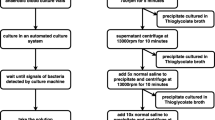Abstract
This study examines the application in a routine laboratory of a method for concentrating and lysing leucocytes in continuous ambulatory peritoneal dialysis (CAPD) effluent to diagnose peritonitis. Between November 1986 and April 1990 pathogens from 42 of 82 (51 %) CAPD specimens from patients with acute peritonitis failed to grow on horse blood agar (HBA) after direct inoculation. Recovery rates of pathogens were 74 % (6 of 82) from a solid medium containing saponin and 89 % (73 of 82) after lysing the leucocytes before inoculating HBA. Microbial sequestration in leucocytes was demonstrated in 73% (60 of 82) of specimens, while pathogens from 11 % (9 of 82) were grown only from a liquid medium. Thirteen of 17 specimens with<500 leucocytes/mm3 grew on all three solid media. Gram stain microscopy revealed organisms in 51 % (41 of 81) of specimens. The method, using apparatus and media prepared for everyday examination of specimens, is sensitive, specific and yields single colonies of most species within 24 h.
Similar content being viewed by others
References
Law D, Freeman R, Tapson J Diagnosis of peritonitis. Journal of Clinical Pathology 1987, 40: 1267.
Ludlam HA, Price TNC, Berry AJ, Phillips I Laboratory diagnosis of peritonitis in patients on continuous ambulatory peritoneal dialysis. Journal of Clinical Microbiology 1988, 26: 1757–1762.
Taylor PC, Poole-Warren LA, Grundy RE Increased microbial yield from continuous ambulatory peritoneal dialysis peritonitis effluent after chemical or physical disruption of phagocytes. Journal of Clinical Microbiology 1987, 25: 580–583.
Buggy BP, Schaberg DR, Schwartz RD Intraleukocytic sequestration as a cause of persistentStaphylococcus aureus peritonitis in continuous ambulatory peritoneal dialysis. American Journal of Medicine 1984, 76: 1035–1040.
Peterson PK, Lee D, Suh HJ, Devalon M, Nelson RD, Keane WF Intracellular survival ofCandida albicans in peritoneal macrophages from chronic peritoneal dialysis patients. American Journal of Kidney Diseases 1986, 7: 146–152.
Verbrugh HA, Keane WF, Hoidal JR, Freiberg MR, Elliott GR, Peterson PK Peritoneal macrophages and opsonins: antibacterial defense in patients undergoing chronic peritoneal dialysis. Journal of Infectious Diseases 1983, 6: 1018–1029.
Duwe AK, Vas SI, Weatherhead JW Effects of the composition of peritoneal dialysis fluid on chemiluminescence, phagocytosis, and bactericidal activity in vitro. Infection and Immunity 1981, 33: 130–135.
von Graevenitz A, Amsterdam D Microbiological aspects of peritonitis associated with continuous ambulatory peritoneal dialysis. Clinical Microbiology Reviews 1992, 5: 36–48.
Howe PA, Fraise AP Continuous ambulatory peritoneal dialysis: factors influencing recovery of organisms from effluents. Medical Laboratory Sciences 1991, 48: 114–117.
Phua RTJ, Winney IR, Ghosh HK The microbiology of peritonitis in continuous ambulatory peritoneal dialysis — experience in a provincial centre 1986–1989. Pathology 1991, 23: 344–345.
Tapsall JW, Cheng JK Rapid identification of pathogenic species ofNeisseria by carbohydrate degradation tests. British Journal of Venereal Diseases 1981, 57: 249–252.
Zierdt CH Blood-lysing solution non-toxic to pathogenic bacteria. Journal of Clinical Microbiology 1982, 15: 172–174.
Armitage P Statistical methods in medical research. Blackwell Scientific Publications, London, 1971, p. 116–126, 211–213.
Antonsen S, Pedersen FB, Wang P, andThe Danish Study Group on Peritonitis in Dialysis Leukocytes in peritoneal dialysis effluents. Peritoneal Dialysis International 1991, 11: 43–47.
Males BM, Walshe JJ, Amsterdam D Laboratory indices of clinical peritonitis: total leucocyte count, microscopy, and microbiologic culture of peritoneal dialysis effluent. Journal of Clinical Microbiology 1987, 25: 2367–2371.
Fenton P Laboratory diagnosis of peritonitis in patients undergoing continuous ambulatory peritoneal dialysis. Journal of Clinical Pathology 1982, 35: 1181–1184.
Korzets Z, Korzets A, Golan E, Zevin D, Bernheim J Continuous ambulatory peritoneal dialysis peritonitis — initial presentation as an acute abdomen with a clear peritoneal effluent. Clinical Nephrology 1992, 37: 155–157.
Aronson MD, Bor DH Blood cultures. Annals of Internal Medicine 1987, 106: 246–253.
Gopaul D, Cordy P Bacterial isolations from peritoneal fluids in continuous ambulatory peritoneal dialysis patients. Canadian Journal of Medical Technology 1984, 46: 186–188.
Author information
Authors and Affiliations
Rights and permissions
About this article
Cite this article
Taylor, P.C. Routine laboratory diagnosis of continuous ambulatory peritoneal dialysis peritonitis using centrifugation/lysis and saponin-containing media. Eur. J. Clin. Microbiol. Infect. Dis. 13, 249–252 (1994). https://doi.org/10.1007/BF01974545
Issue Date:
DOI: https://doi.org/10.1007/BF01974545




